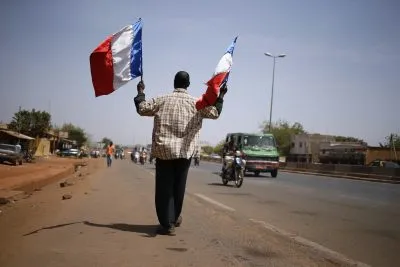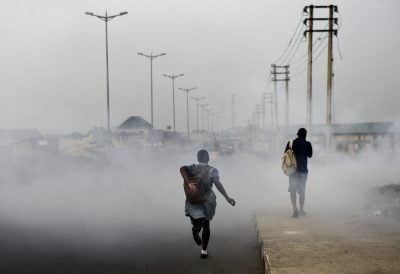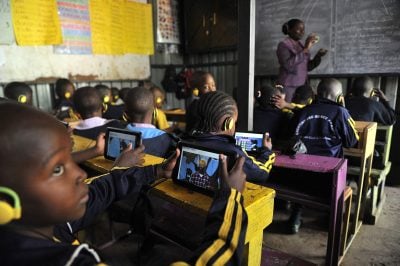While the presidential election in Ghana did not receive as much global attention as elections in the US and Europe, the West African state’s peaceful contest signaled hope at a time when the continent has been reeling from economic stagnation.
Some expected the hotly contested battle between the incumbent John Mahama of the National Democratic Congress and leader of the opposition Nana Akufo-Addo of the New Patriotic Party to turn ugly when voting began on 8th December, perhaps leading to a run-off later in the year. Instead, once the electoral commission revealed the results on 10th December, celebrations and street parties ensued.
Without protest, President Mahama conceded the result, gracefully accepted defeat and wished the president-elect good luck. The elections were met with praise and approval from spectators across the continent and beyond.
“Ghana’s reaction towards the election results were truly amazing,” says Alex Vines, head of the Africa Programme at Chatham House. “There was very, very little violence in its run-up or afterwards.”
In Ghana, the electorate voted for change as economic progress stagnated. Growth was only given a boost following a three-year programme with the IMF that came into action in 2015 – three years after Mahama came into office and seven years after the NDC came into power. Ghanaians will now expect tangible economic benefits in 2017 to coincide with political change.
Africans are increasingly holding their leaders to account: unless economic growth and development begins to actually trickle down to the masses, inflexible leaders and governments will either fall or be forced to adapt. “Young populations are increasingly becoming politically and economically savvy. They will not accept the status quo if it doesn’t lead to economic growth and to a certain extent this is what happened in Ghana,” says Vines.
Next year, elections in Rwanda and Kenya will gauge the incumbents’ success in driving economic growth and development. Angola’s long-serving President José Eduardo dos Santos announced that he will step down in 2018 and some unity could be restored to South Africa’s African National Congress when President Jacob Zuma’s second term runs out. Political change is on the horizon and hopefully transitions will be peaceful. But Africa cannot depend on peaceful democratic elections alone for success in 2017.
“When are we going to see leaders turning talk into action? There are of course some bright spots on the continent – Rwanda and Ethiopia stand at as just two examples for me – but we need to see tangible economic change and resolute policy decisions,” says Arnold Ekpe, honorary President at the Business Council for Africa and former CEO of Ecobank. “Weneed to start being more critical of our leaders.” But will we see political changes translate into real economic change in 2017? “Unfortunately, I think next year will be much of the same,” he says.
Structural reform
Structural reform and economic diversification for sustainable growth in Africa has not lived up to expectations. Some of the continent’s largest economies continue to rely on extracting commodities such as oil, gas and minerals, leaving their countries vulnerable to external and internal shocks.
Weaknesses in Nigeria, Angola, Gabon and those in the Central African Economic and Monetary Union have become shockingly apparent over the last two years as commodity prices collapsed, demand for natural resources in China fell and global economic growth slowed. Africa remained largely unscathed following the global financial crisis in 2008, but as the continent has become much more integrated into the global economy since then, its growth trajectory is following that of its global peers: downhill.
With a slight pick-up in commodity prices, however, growth should strengthen in 2017. Ratings agency Moody’s predicts that GDP growth for 2016 will be 1.9%, rising to around 3.5% in 2017. The IMF estimates African GDP growth for 2016 at just 1.5% – the lowest in 20 years – with a slight recovery expected in 2017. This is a far cry from the boom between 2010 and 2015 when GDP growth outperformed global rates at an average of 4.4% a year.
Despite the boost to growth, next year will be a continuation of 2016 for most commodity producers. As Abebe Aemro Selassie, director of the African Department at the IMF says: “Policy response in many countries affected by these shocks has been delayed and incomplete and this raises uncertainty, deters private investment and stifles new sources of growth.”
For commodity producers, pain is spreading beyond oil-related sectors to the entire economy and risks becoming deeply entrenched. Internal fiscal and monetary pressures have mounted. Foreign exchange reserves have diminished as countries such as Nigeria and Angola pump their economies with dollars and artificially inflate local currencies.
“African central banks need to show some restraint when it comes to using diminishing reserves to support their currencies,” says Makhtar Diop, vice president of the Africa region at the World Bank. “And unless currencies are allowed to float freely, black markets will thrive, imports will become much more expensive and economic growth will continue to suffer. When a currency is based on market supply and demand, countries are much more likely to adjust to external shocks.”
When Egypt floated its currency in November 2016, it lost 50% of its value against the dollar but investors took this as a positive sign and stock markets rallied. Nigeria, however, which floated its currency in June 2016 has continued struggle.
“Markets seem to indicate that the naira has yet to settle at its equilibrium value and the parallel market is in fact trading at significantly different levels,” says Miguel Azevedo, head of investment banking at Citigroup. “Nigeria has definitely faced short-term challenges but I believe growth will resume once the equilibrium has been found.
In 2017 we will see a better than expected growth in Nigeria and with that further capital market and M&A activity,” he says. Yet the full picture of sub-Saharan Africa is one of multi-speed growth, in which the regional average masks considerable diversity across the region. There are some bright spots throughout the continent, namely smaller countries that have much more diversified economic bases and are net importers of oil and gas.
“It’s a common misconception that Africa is dominated by net-commodity exporters. In terms of GDP this might be the case, but most countries in Africa are commodity importers,” says Donald Kaberuka, Rwandan economist and president at the African Development Bank (AfDB) until May 2015.
Coming from a small base, sustainable development and structural reform in Senegal and Côte d’Ivoire has caught the eye of investors. With the fall in oil and gas prices, countries including Rwanda, Kenya, Uganda and Ethiopia have been able to manage their balance of payments and redirect cash into investing within the country. Both trends will continue into 2017.
Dealing with debt
African countries that have seen growth falter have turned to the IMF, the AfDB and other development finance institutions for a lifeline. Some of the hardest hit – Mozambique, Zambia and Zimbabwe where debt-to-GDP levels are becoming difficult to manage – will need to make huge fiscal adjustments to qualify for help from any institution.
But turning to multilaterals and development finance institutions for debt makes sense in tough times as concessional financing from these institutions is cheaper, especially at a time when international capital markets are becoming much more expensive. When Africa’s Eurobond markets came into full flow in 2014, yields on debt were in the single digits.
Fast forward to 2016, and international investors are expecting higher yields with shorter maturities to match their risk appetite. It will be a similar story in 2017. “With Fed hikes in the US as well as more optimistic economic growth expectations, typically we see a diversion of funds from emerging markets back to their developed counterparts and this will impact capital market activity in 2017,” says Azevedo.
But there are reasons to be optimistic. “Some portfolio flows are returning to developed markets as they predict a Fed rate hike in 2017 but not all. Investors in search of yield [greater returns] will still find ample opportunity in Africa especially when compared to other emerging markets in Eastern Europe and Asia. Whether African sovereigns will see international debt worth their while is a different story,” says Kaberuka.
For businesses, “the corporate bond market has been a pleasant surprise, particularly given the volatility in the first half of the year,” says James Nelson, head of debt capital markets, Africa, at Standard Chartered. For example, despite Nigeria’s dire economic situation, corporates such as telecommunications towers company IHS and Access Bank both managed to issue successful Eurobonds. In October 2016, IHS raised $800m over five years with a yield of 9.5% – the largest single tranche ever issued from Nigeria, and Access Bank raised a $300m Eurobond over five years at 10.5%.
Investors are beginning to look much more closely at credit metrics including size of issuance, debt repayment commitments, future growth potential and where the use of proceeds is made clear, rather than looking at the whole of sub-Saharan Africa as one uniform asset class. Investors will increasingly differentiate between companies and countries as places for viable investment into 2017 onwards.
Access to capital markets will be a boon for corporates gunning to become the continent’s commercial champions in 2017 and beyond, especially at a time when domestic credit is hard to come by. Interest rates are notoriously high in Africa and reliable government borrowing from local African banks often crowds out corporates, limiting their options for reliable, cheap and long-term financing.
At the same time, support from international banks on the ground is dwindling. Some, such as Barclays are pulling out of Africa to concentrate on their businesses back home and in implementing Basel III recommendations. Others, such as BNP Paribas will be cutting back on their Africa operations because of hefty fines imposed on them after violating sanctions in Sudan, Cuba and Iran.
Threat of insularity
With a swathe of nationalist political tendencies in the US and Europe, developed markets are becoming more insular, and the way in which they approach Africa in terms of trade, aid and investment will change from 2017 onwards. Africa will increasingly need to look nationally and regionally for support and will do well to ensure this is firmly on the agenda from the new year.
“Access to finance for small to medium enterprises in Africa is falling and although this is not entirely Africa’s fault we are the ones that will need to rise to the plate, stimulate economies and support businesses through the creation of larger financial institutions,” says Ekpe.
“There will need to be some consolidation in the banking sector in order to create larger financial institutions with the balance sheets to support SMEs; we need to break down borders and encourage the free movement of people and goods between countries. By supporting each other, only then will we be able to create regional and global champions,” he says.
For 2017, there is a hope that African countries overly dependent on commodities will look to diversify their economic base, develop capital markets and boost interconnectivity to cushion themselves from shocks felt in the commodity downturn over the last couple of years. But will these meaningful structural changes take much longer to implement as commodity prices creep up? Will diversification take a back seat?
“Hoping that countries will meaningfully diversify their economies is not a strategy. Hoping people will learn from past mistakes is not a strategy. What Africa needs are major structural reforms, not hope,” says Ekpe.
Kanika Saigal
Want to continue reading? Subscribe today.
You've read all your free articles for this month! Subscribe now to enjoy full access to our content.
Digital Monthly
£8.00 / month
Receive full unlimited access to our articles, opinions, podcasts and more.
Digital Yearly
£70.00 / year
Our best value offer - save £26 and gain access to all of our digital content for an entire year!
 Sign in with Google
Sign in with Google 


